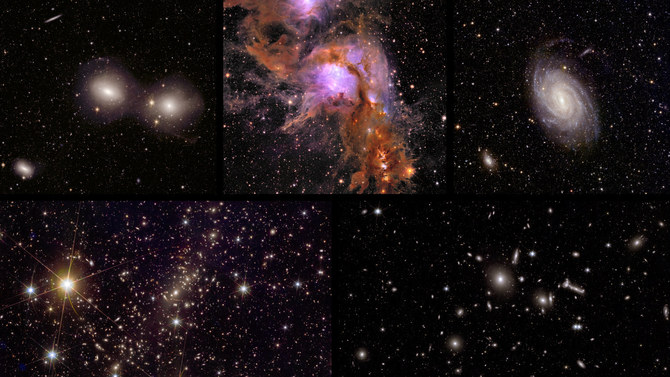ROSWELL, New Mexico: Austrian extreme athlete Felix Baumgartner landed gracefully on Earth Sunday after a 24-mile (38.6-kilometer) jump from the stratosphere in a dramatic, record-breaking feat that officials said made him the first skydiver to fall faster than the speed of sound.
Baumgartner came down in the eastern New Mexico desert about nine minutes after jumping from his capsule 128,100 feet (39,045 meters), or roughly 24 miles (38.6 kilometers), above Earth. He lifted his arms in victory shortly after landing, setting off loud cheers from jubilant onlookers and friends inside the mission’s control center in Roswell, New Mexico.
“When I was standing there on top of the world, you become so humble, you do not think about breaking records anymore, you do not think about gaining scientific data. The only thing you want is to come back alive,” he said after the jump.
Brian Utley, a jump observer from the International Federation of Sports Aviation, said preliminary figures show Baumgartner reached a maximum speed of 833.9 mph (1,342 kph). That amounts to Mach 1.24, which is faster than the speed of sound. No one has ever reached that speed wearing only a high-tech suit.
Baumgartner says that traveling faster than sound is “hard to describe because you don’t feel it.” With no reference points, “you don’t know how fast you travel,” he told reporters.
“Sometimes we have to get really high to see how small we are,” he said.
The altitude he leapt from also marked the highest-ever for a skydiver — more than three times the height of the average cruising altitude for a jetliner. Organizers said the descent lasted just over nine minutes, about half of it in free fall. Utley said he traveled 119,846 feet (36,529 meters) in free fall.
Three hours earlier, Baumgartner, known as “Fearless Felix,” had taken off in a pressurized capsule carried by a 55-story ultra-thin helium balloon. After an at-times tense ascent, which included concerns about how well his facial shield was working, the 43-year-old former military parachutist completed a final safety check-list with mission control.
As he exited his capsule from high above Earth, he flashed a thumbs-up sign, well aware that the feat was being shown on a live-stream on the Internet with a 20-second delay.
Any contact with the capsule on his exit could have torn his pressurized suit, a rip that could expose him to a lack of oxygen and temperatures as low as minus 70 degrees Fahrenheit (minus 57 degrees Celsius). That could have caused lethal bubbles to form in his bodily fluids.
But none of that happened. He activated his parachute as he neared Earth, gently gliding into the desert east of Roswell and landing without any apparent difficulty. The images triggered another loud cheer from onlookers at mission control, among them his mother, Eva Baumgartner, who was overcome with emotion, crying.
He then was taken by helicopter to meet fellow members of his team, whom he hugged in celebration.
Coincidentally, Baumgartner’s attempted feat also marked the 65th anniversary of US test pilot Chuck Yeager’s successful attempt to become the first man to officially break the sound barrier aboard an airplane.
At Baumgartner’s insistence, some 30 cameras on the capsule, the ground and a helicopter recorded the event Sunday. While it had been pegged as a live broadcast, organizers said was actually under a 20-second delay in case of a tragic accident.
Shortly after launch, screens at mission control showed the capsule as it began rising high above the New Mexico desert, with cheers erupting from organizers. Baumgartner could be seen on video, calmly checking instruments inside the capsule.
Baumgartner’s team included Joe Kittinger, who first attempted to break the sound barrier from 19.5 miles (31.4 kilometers) up in 1960, reaching a speed of 614 mph (988 kph), just under the sound barrier. With Kittinger inside mission control Sunday, the two men could be heard going over technical details during the ascension.
“Our guardian angel will take care of you,” Kittinger radioed to Baumgartner around the 100,000-foot (30,000-meter) mark. Kittinger noted that, it was getting “really serious” now.
An hour into the flight, Baumgartner had ascended more than 63,000 feet (19,200 meters) and had gone through a trial run of the jump sequence that will send him plummeting toward Earth. Ballast was dropped to speed up the ascent.
Kittinger told him, “Everything is in the green. Doing great.”
As Baumgartner ascended in the balloon, so did the number of viewers watching on YouTube. Nearly 7.3 million watched as he sat on the edge of the capsule moments before jumping. After he landed, Red Bull posted a picture of Baumgartner on his knees on the ground to Facebook, generating nearly 216,000 likes, 10,000 comments and more than 29,000 shares in less than 40 minutes.
On Twitter, half the worldwide trending topics had something to do with the jump, pushing past seven National Football League games.
Among the tweets was one from NASA: “Congratulations to Felix Baumgartner and RedBull Stratos on record-breaking leap from the edge of space!“
This attempt, sponsored by the energy drink maker Red Bull, marked the end of a five-year road for Baumgartner, a record-setting high-altitude jumper. He had already made two preparation jumps in the area, one from 15 miles (24 kilometers) high and another from 18 miles (29 kilometers) high. It will also be the end of his extreme altitude jumping career; he has promised this will be his final jump.
Baumgartner has said he plans to settle down with his girlfriend and fly helicopters on mountain rescue and firefighting missions in the US and Austria.
Dr. Jonathan Clark, Baumgartner’s medical director, had told reporters he expected the pressurized spacesuit to protect him from the shock waves of breaking the sound barrier. A successful jump could lead NASA to certify a new generation of spacesuits for protecting astronauts and provide an escape option from spacecraft at 120,000 feet (36,000 meters), he said.
Austrian skydiver lands safely after 24-mile leap to Earth
Austrian skydiver lands safely after 24-mile leap to Earth

Kodi, star of ‘Dog on Trial,’ takes home Cannes’ top dog prize

- The Griffon mix was praised for his “breathtaking” performance as Cosmos, a guide dog for a visually impaired man
- Xin, the greyhound who made a star turn in Chinese director Guan Hu’s “Black Dog,” was awarded the Palm Dog’s Grand Jury Prize
CANNES, France: There was lots of tail-wagging and face-licking as Kodi, this year’s winner of the Palm Dog, the canine equivalent of the Cannes Film Festival’s top prize, went up to receive his red collar for the French comedy “Dog on Trial” on Friday.
The Griffon mix was praised for his “breathtaking” performance as Cosmos, a guide dog for a visually impaired man, who goes on trial over an attack, in a case whose outcome could mean death.
“This film is very significant because it not only explores the bond between humans and dogs but it takes a satirical, comedic but quite profound look at the way that we domesticate dogs and the way that we relate to dogs, and the way our justice system relates to dogs,” said critic and jury member Anna Smith.
Xin, the greyhound who made a star turn in Chinese director Guan Hu’s “Black Dog,” was awarded the Palm Dog’s Grand Jury Prize.
Xin was in Cannes to don the red collar for the film about an ex-convict tasked with ridding his town of stray dogs who befriends one of them.
The unofficial awards show, which was created in 2001, is now in its 24th edition.
Kodi succeeds last year’s winner, Messi from Justine Triet’s “Anatomy of a Fall,” who converted his star power into a French TV show in which he, through the voice of French humorist Raphael Mezrahi, interviews people at this year’s festival.
Other past winners include Brandy, a pit bull belonging to Brad Pitt’s character in “Once Upon a Time in Hollywood” and Tilda Swinton’s spaniels, who co-starred with her in a film directed by Joanna Hogg.
Massive cradle of baby stars revealed in new space telescope images

- The European Space Agency released the photos from the Euclid observatory on Thursday
- Euclid will spend the next several years observing billions of galaxies covering more than one-third of the sky
CAPE CANAVERAL, Florida: A massive cradle of baby stars has been observed in new detail by a European space telescope, adding to its celestial collection of images.
The European Space Agency released the photos from the Euclid observatory on Thursday.
They were taken following the telescope’s Florida launch last year as a warm-up act to its main job currently underway: surveying the so-called dark universe.
From its perch 1 million miles (1.6 million kilometers) from Earth, Euclid will spend the next several years observing billions of galaxies covering more than one-third of the sky.
The shape and size of all these galaxies can help scientists understand the mysterious dark energy and dark matter that make up most of the universe.
“Euclid is at the very beginning of its exciting journey to map the structure of the universe,” the space agency’s director general, Josef Aschbacher, said in a statement.
Among the newly released pictures is one of an enormous cradle of baby stars some 1,300 light-years away known as Messier 78. A light-year is 5.8 trillion miles. Euclid’s infrared camera peered through the dust enveloping the stellar nursery, revealing new regions of star formation, according to ESA.
Daily marijuana use outpaces daily drinking in the US, a new study says

- In 2022, an estimated 17.7 million people reported using marijuana daily or near-daily compared to 14.7 million daily or near-daily drinkers,
- The number of daily users suggests that more people are at risk for developing problematic cannabis use or addiction, says researcher
For the first time, the number of Americans who use marijuana just about every day has surpassed the number who drink that often, a shift some 40 years in the making as recreational pot use became more mainstream and legal in nearly half of US states.
In 2022, an estimated 17.7 million people reported using marijuana daily or near-daily compared to 14.7 million daily or near-daily drinkers, according an analysis of national survey data. In 1992, when daily pot use hit a low point, less than 1 million people said they used marijuana nearly every day.
Alcohol is still more widely used, but 2022 was the first time this intensive level of marijuana use overtook daily and near-daily drinking, said the study’s author, Jonathan Caulkins, a cannabis policy researcher at Carnegie Mellon University.
“A good 40 percent of current cannabis users are using it daily or near daily, a pattern that is more associated with tobacco use than typical alcohol use,” Caulkins said.

The research, based on data from the National Survey on Drug Use and Health, was published Wednesday in the journal Addiction. The survey is a highly regarded source of self-reported estimates of tobacco, alcohol and drug use in the United States.
From 1992 to 2022, the per capita rate of reporting daily or near-daily marijuana use increased 15-fold. Caulkins acknowledged in the study that people may be more willing to report marijuana use as public acceptance grows, which could boost the increase.
Most states now allow medical or recreational marijuana, though it remains illegal at the federal level. In November, Florida voters will decide on a constitutional amendment allowing recreational cannabis, and the federal government is moving to reclassify marijuana as a less dangerous drug.
Research shows that high-frequency users are more likely to become addicted to marijuana, said Dr. David A. Gorelick, a psychiatry professor at the University of Maryland School of Medicine, who was not involved in the study.
The number of daily users suggests that more people are at risk for developing problematic cannabis use or addiction, Gorelick said.
“High frequency use also increases the risk of developing cannabis-associated psychosis,” a severe condition where a person loses touch with reality, he said.
Russian court fines man for hair dyed in colors of Ukrainian flag, OVD-Info says

- Photographs of Stanislav Netesov posted online show the 25-year-old’s close-cropped hair colored bright blue, green and yellow
- Netesov was found guilty of discrediting the armed forces on May 3, an online court notice shows, although it does not specify a fine
LONDON: A Russian man who had his hair dyed in some of the colors of the Ukrainian flag has been fined 30,000 roubles ($330) by a court for “discrediting” the Russian army, rights group OVD-Info reported on Monday.
Photographs of Stanislav Netesov posted online show the 25-year-old’s close-cropped hair colored bright blue, green and yellow. Blue and yellow are the colors of the Ukrainian flag.
More than 20,000 people have been detained for their anti-war stance since the start of Moscow’s full-scale invasion of Ukraine in February 2022, with over 900 people charged with criminal offenses.
Netesov was found guilty of discrediting the armed forces on May 3, an online court notice shows, although it does not specify a fine.
In court, Netesov denied his hair color was meant as a statement of protest, saying that he does not support either Ukraine or the Russian army, independent news outlet Mediazona reported. He said he has dyed his hair bright colors for years.
Netesov could not be reached for comment.
The case against the Muscovite began in late April, when he was attacked by unknown people while returning home from work late at night.
The assailants stole his mobile phone and knocked out one of his teeth, Netesov told OVD-Info, which assists those targeted for opposing the war.
When he went to the police to file a report, officers noticed his hair and charged him under the “discrediting” statute, Mediazona reported.
“The aforementioned visual propaganda clearly expressed a negative attitude toward the Armed Forces of the Russian Federation,” Mediazona cited the police report as saying.
Officers also gave Netesov a summons to report to a military enlistment office. He then revealed to them he was a transgender man, after which they canceled the summons, Mediazona said.
Swarmed with tourists, Japan town blocks off viral view of Mt. Fuji

- The mass of visitors and their refusal to obey rules on littering and parking had become a nuisance and traffic hazard
FUJIKAWAGUCHIKO, Japan: Japan’s majestic Mt. Fuji was some 700,000 years in the making, but on one sultry May morning, it was gone.
At least on one side of a busy road, views of the 3,776-meter (12,388 foot) symbol of Japan and the Lawson convenience store beneath it have vanished, as officials finished a 20-meter by 2.5-meter barrier to obstruct a photo spot that had become viral among tourists.
For locals, the mass of visitors and their refusal to obey rules on littering and parking had become a nuisance and traffic hazard.
“I’m really happy that foreigners are coming to our town,” said Kikue Katsumata, 73, a lifelong resident of Fujikawaguchiko. “But when it comes to taking pictures from the Lawson, the road is a bit narrow and it can be dangerous when people dash across without using a crosswalk.”
March and April set all-time records for visitor arrivals, driven by pent-up demand after the pandemic and as the yen’s slide to a 34-year low made Japan an irresistible bargain. That’s been good news for the economy, with travelers spending a record 1.75 trillion yen ($11.2 billion) in the first three months of 2024, according to the tourist agency.
The drastic decision to block the view of Mt. Fuji symbolizes tensions across the country as Japan reckons with the consequences of its tourism boom. The western metropolis of Osaka and the hot spring resort town Hakone are among municipalities considering new tourism taxes to deal with deluge of visitors.
Cyril Malchand, a 45-year old visitor from France, found out about the fence online and made a special trip to be among the last to take in the view. He said he empathized with the locals.
“When I see that there could be problems with people crossing the road without watching cars, I don’t find it that bad that they’re setting up that fence,” he said.




















